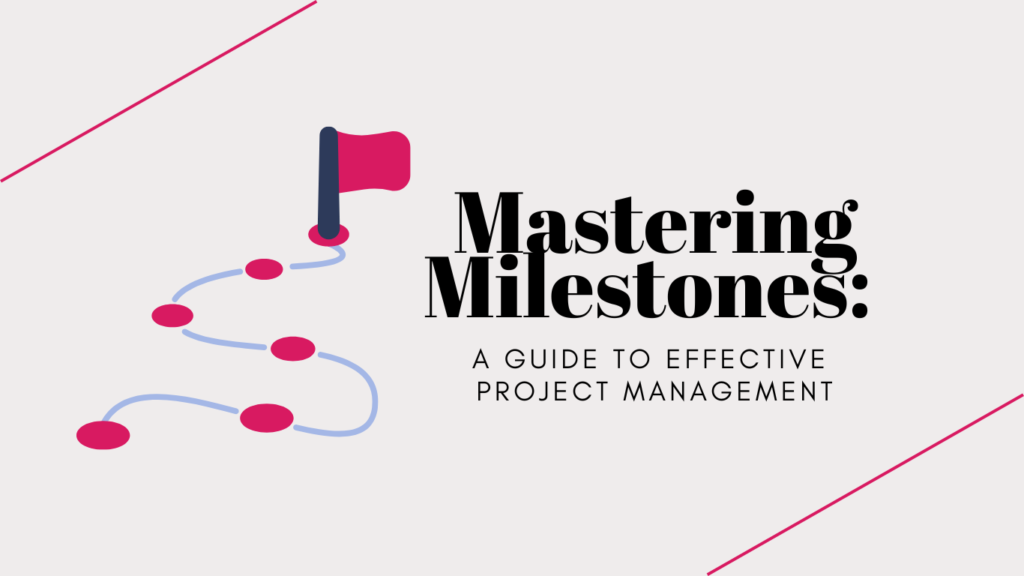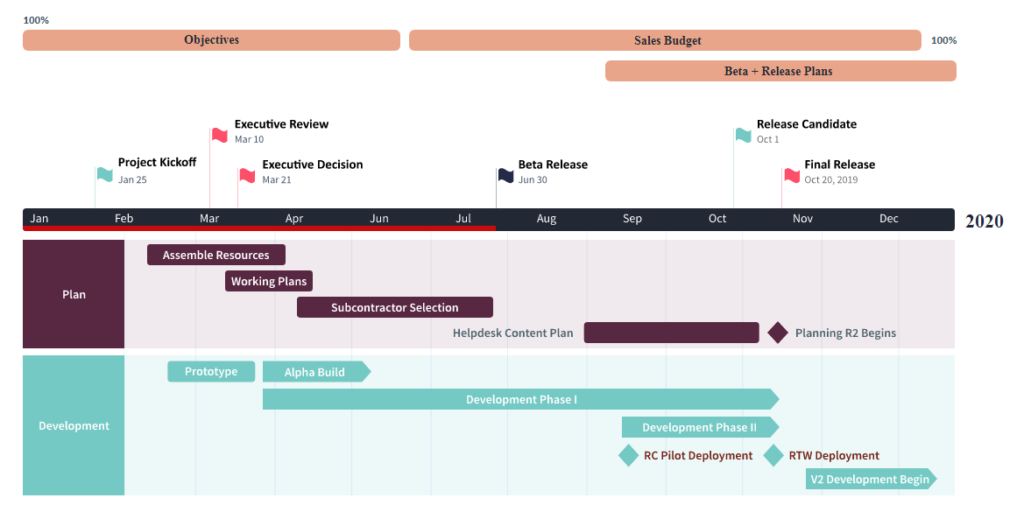Project Milestones in Project Management

Setting project milestones can be the difference between success and failure in project management. Milestones are critical points in a project that marks progress toward a larger goal. Without effective milestones, it can be difficult to keep a project on track, and stakeholders may struggle to understand the progress being made.
Milestones also allow you to identify potential issues early and adjust your approach as needed. By setting clear, achievable milestones, you can ensure that your project stays on track and meets the needs of all involved! In this post, we’ll explore the importance of setting project milestones and provide some tips for creating effective ones that will help you achieve your goals. Stay tuned!

What Are Milestones?
Milestones are key events or stages in a project that indicate progress toward a specific goal. They act as markers that help track progress and enable project managers to assess if the project is on track to meet its objectives. Milestones are usually identified early in the project planning phase and are used to help create a timeline for the project.
Milestones in project management might include:
- Completing the project planning phase
- Reaching a specific stage in the development process
- Delivering a key component of the project
- Reaching a specific deadline or target date
However, it’s important to note that milestones are not the same as goals.
Goals vs. Milestones
Goals and milestones are both important elements in achieving success, but they serve different purposes in the overall process. Here are some specific differences between the two:
Goals are broad, long-term objectives that provide direction and focus for an individual or organization. Goals could be:
- Increase revenue by 20% this year
- Launch a new product line within the next 18 months
- Earn a promotion to manager-level within the next 2 years
Milestones are specific, measurable achievements that mark progress toward a goal. Milestones could be:
- Hire a new sales team member by the end of the month
- Complete the design phase of the new product line by the end of the quarter
- Attend a leadership seminar to develop skills needed for a management role
In summary, goals provide overarching direction and purpose, while milestones provide checkpoints to track progress toward achieving those goals. Yet, both are necessary components of successful planning and execution.
Milestones in Project Management
In project management, milestones are specific points in a project timeline that are used to measure progress and ensure that the project is meeting its objectives. For example, a milestone in project management could be the completion of the project plan. This marks the end of the planning phase and the beginning of the execution phase!
Milestones in a project could look like this:

Milestones in project management allow you to celebrate progress and build momentum toward the final goal
According to Project Management Institute (PMI), 37% of failures in projects are due to a lack of defined objectives and milestones. And, no one wants to fail, right? So, apart from guaranteeing you success in your new project, setting milestones offer you other benefits.
Some benefits of setting milestones include:
- Increased clarity and focus
- Improved communication with stakeholders
- Enhanced project management and scheduling
- Better risk management and issue resolution
- Increased motivation and engagement among team members
Now, you could be wondering. How do I identify milestones? What if I mistake them as goals? Let’s help you out!
How to Define Project Milestones?
Defining project milestones is a critical aspect of project management. Without milestones, it can be difficult to determine if a project is progressing as planned or if it’s falling behind schedule.
Identify Major Deliverables
The first step in defining project milestones is to identify the major project deliverables. These are the key outputs or outcomes that need to be achieved to successfully complete the project. Once these deliverables have been identified, project teams can work backward to identify the key milestones that need to be achieved along the way.
For example, if a project involves building a new website, key deliverables may include creating wireframes, designing the user interface, and developing the website. Key milestones could include completing the wireframes, finalizing the user interface design, and launching the website.
Break Down into Smaller Tasks
Once the project deliverables have been identified, it is necessary to identify and define the smaller tasks that need to be completed to achieve those deliverables. Breaking down the project into smaller tasks also helps to identify the critical tasks that are crucial to the success of the project and those that can be completed at a later stage.
By dividing the project into smaller tasks, it becomes easier to manage and monitor progress, as well as track the completion of each task. It also enables project managers to delegate tasks to team members more effectively, based on each team member’s skills and expertise.
Establish Criteria
Then you need to establish clear criteria for each milestone. These criteria should be specific, measurable, and achievable. For example, if a milestone is to complete the wireframes, the criteria could be that all wireframes are created and approved by the client.
The criteria for each milestone should be agreed upon by all project stakeholders and documented in the project plan. This helps to ensure that everyone is on the same page and that there is a clear understanding of what needs to be achieved at each milestone.
Milestones in Project Management Examples
Let’s consider the scenario of a software development company tasked with creating a new mobile application for their client.
Defining Project Scope
To begin, the project manager would work with the client to establish the overall scope and requirements for the app. Once this is done, the team can start setting specific milestones to ensure the project stays on track, and that everyone involved is aware of the timeline and expected deliverables.
- The first milestone might be to complete the app’s design and user interface. This would involve creating wireframes and mock-ups of the app’s screens and getting approval from the client before moving on to development. Once this milestone is reached, the team can move on to the next phase of the project.
- The second milestone might be to complete the app’s development and testing. This would involve actually building the app, and testing it extensively to ensure it functions properly and meets all of the client’s requirements. Once this milestone is achieved, the team can move on to the final phase of the project.
- The final milestone might be to launch the app in the app store. This would involve submitting the app to both Apple and Google’s app stores, and ensuring that it is approved and ready for public consumption. Once this milestone is finished, the project is complete, and the team can move on to the next project.
Easy enough, eh?
Mastering Milestones: A Guide to Effective Project Management
Getting into work! Below, you will find the best practices for setting milestones for successfully managing projects from start to finish. This guide is designed to help project managers and team members navigate the complexities of project management and achieve their goals.
Read below!
Start with a Clear Project Plan
You can’t start setting good milestones without a good project plan!
The first step in setting milestones is to have a clear and well-defined project plan. This plan should include all the phases of the project, the tasks that need to be completed in each phase, and the specific deliverables that are expected at each milestone. This will help ensure that all team members are on the same page and understand the overall goals of the project.
Involve all Stakeholders
To effectively manage a project, it is important to involve all stakeholders in the process of setting milestones. This means consulting with the project team, sponsors, and customers to gather input and feedback on the goals and timelines of the project. By involving all stakeholders, everyone can be on the same page about the objectives of the project and how they will be achieved.
The project team can provide insights into the technical aspects of the project, while sponsors and customers can provide feedback on the practicality of the milestones. By working collaboratively, milestones can be set that accurately reflect the complexity of the project, the resources available, and the desired outcomes.
Make the Milestones Specific and Measurable
Specific and measurable milestones mean the milestone should clearly state what is being accomplished, and there should be a way to objectively measure progress toward achieving it. For example, instead of setting a milestone to “improve sales,” a more specific and measurable milestone would be “increase sales by 10% within the next quarter.” This allows for a clear understanding of what needs to be achieved, and how progress will be tracked.
Another example of a specific and measurable milestone could be a software development project. Instead of setting a milestone to “improve user experience,” a more specific and measurable milestone would be “reduce the average load time of the website to under 3 seconds.” This not only sets a clear goal for the development team but also provides a way to objectively measure progress toward achieving it.
Set Realistic Timelines
Setting realistic timelines for project milestones is crucial for effective project management. It can help prevent missed deadlines and ensure that the project is completed on time. To achieve this, it’s important to consider different factors such as the availability of resources, the project’s complexity, and potential risks or challenges.
For instance, if a project involves extensive research, it’s important to factor in the time needed for the research process. This might include time for literature review, data collection, and analysis. Additionally, if a project involves multiple stakeholders, it’s important to consider the time needed for communication and collaboration among them.
- If project milestones are too aggressive or unrealistic, it can lead to poor quality work, missed deadlines, and project delays.
For example, if a project is assigned to a team that lacks the necessary skills and resources, unrealistic timelines can cause the team to rush the work, resulting in a subpar output. Therefore, it’s crucial to set realistic timelines that consider the project’s requirements and the team’s capabilities to ensure that the project is completed successfully.
Adjust Milestones as Needed
Milestones should be reviewed and adjusted as needed throughout the project lifecycle. This means taking into account any changes in project scope, resource availability, or other factors that may impact the project timeline. By regularly reviewing and adjusting milestones, project managers can ensure that the project stays on track and meets its objectives.
It’s worth noting that milestones may vary depending on the industry and type of project. For example, in a software development project, milestones may include completing the development of a specific feature or module, while in a construction project; milestones may include completing the foundation or framing of a building.
Project Milestones Chart Template
You can find a lot of project milestone templates on the internet. Those in the Gantt format are a powerful tool for project managers to communicate project timelines and milestones to stakeholders. The Gantt chart format is an intuitive visual representation of a project’s timeline, allowing project managers to easily track progress and identify potential delays.

As you can see above, the template typically includes a timeline with a series of bars representing the duration of each task, as well as a series of milestones represented by diamonds. These milestones are critical points in the project timeline that mark the completion of key deliverables or the achievement of important project objectives.
By visually displaying these milestones, stakeholders can quickly understand how the project is progressing and whether it is on track to meet its goals.
Final Thoughts
As milestones provide a structured approach to project delivery, ensuring that progress is tracked and objectives are met, they play a crucial role in project management. For everyone involved in a project, from the project manager to the team members, milestones provide a clear understanding of what needs to be accomplished and by when. The importance of milestones cannot be overstated, as they help keep the project on track, mitigate risks, and ensure that everyone is working towards the same goals.
As you move forward with your projects, you must establish clear and achievable milestones. By doing so, you will be setting yourself up for success, and ensuring that your team is working efficiently and effectively towards a common goal. Set yourself up for success!
-The Monitask Team


